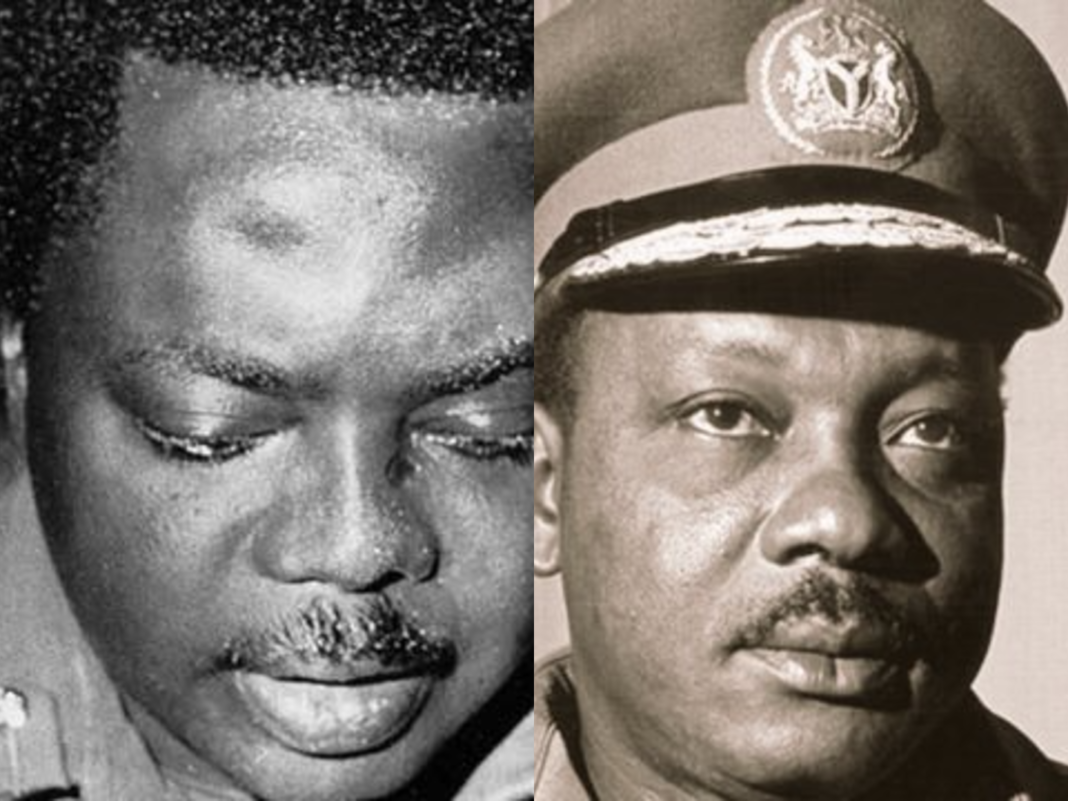Leadership in post-independence Nigeria came with immense pressure. These leaders had to balance ethnic tensions, establish democratic governance, and unite over 250 ethnic groups in a newly sovereign state.
At the time, Nigeria’s political history was marked by moments of turbulence, courage, and sacrifice and among the most tragic chapters are the assassinations of two of its former heads of state: General Johnson Thomas Umunnakwe Aguiyi-Ironsi and General Murtala Ramat Muhammed.
These leaders, though in power for brief periods, left significant marks on the nation’s governance and identity. Their violent deaths not only shocked the country but also altered the trajectory of Nigeria’s political landscape.
RECOMMENDED: See how much President Tinubu really earns in Office
Both Aguiyi-Ironsi and Murtala Muhammed emerged during these defining years. Each took the reins of power at a critical time, faced internal and external pressures, and sought to implement bold reforms before their lives were abruptly cut short.
Their assassinations were not merely acts of violence but outcomes of political, ethnic, and ideological struggles. In both cases, dissatisfaction within the military and tensions among Nigeria’s diverse ethnic groups played a significant role.
The loss of these leaders raised enduring questions about the cost of power, national unity, and the dangers of military rule.
ALSO READ: Top 10 most corrupt countries in the world | Where does Nigeria rank?
2 Nigerian presidents Who Were Assassinated In Office
General Johnson Aguiyi-Ironsi (1924–1966)
Johnson Thomas Umunnakwe Aguiyi-Ironsi was born on March 3, 1924, in Umuahia, present-day Abia State. He joined the Nigerian Army in 1942 and rose quickly through the ranks. Aguiyi-Ironsi was known for his discipline, charisma, and administrative competence, eventually becoming the first Nigerian to command the entire national army.
He assumed office on January 16, 1966, following Nigeria’s first military coup, which saw the assassination of Prime Minister Abubakar Tafawa Balewa and other key northern and western political leaders. Although the coup was carried out by junior Igbo officers, Aguiyi-Ironsi, an Igbo himself, was not directly involved. Nevertheless, he stepped in to restore order and was invited by political leaders to lead the country and prevent a descent into chaos.
Achievements
During his short reign, Aguiyi-Ironsi aimed to centralise Nigeria’s government and foster national unity. One of his most controversial actions was the promulgation of Decree No. 34, which sought to abolish the federal structure in favour of a unitary system.
Although he intended for it to reduce ethnic divisions and streamline governance, many perceived it as an Igbo attempt to dominate the rest of the country, especially by the northern elite. Despite his intentions, Aguiyi-Ironsi struggled to contain growing resentment and suspicion, particularly in the north. His failure to prosecute the January coup plotters (mostly Igbo officers) further deepened the mistrust.
EXPLORE: Otti inaugurates 1st ever 6-lane road in Abia named after Aguiyi Ironsi
Assassination
On July 29, 1966, a counter-coup was launched by northern military officers, outraged by the earlier killings and Aguiyi-Ironsi’s centralisation policies. He was captured in Ibadan, along with his host, Lt. Col. Adekunle Fajuyi (the military governor of Western Region). Both men were brutally murdered. The coup was led by officers including Lt. Col. Murtala Muhammed, Theophilus Danjuma, and Major Ibrahim Babangida, marking a violent shift in Nigeria’s leadership.
YOU MIGHT LIKE: 8 Nigerian state governors who bought expensive jets while in office
General Murtala Muhammed (1938–1976)
Murtala Ramat Muhammed was born on November 8, 1938, in Kano. He was a bold and outspoken officer who joined the Nigerian Army in 1958 and quickly built a reputation for toughness and decisiveness. He played a key role in the counter-coup of July 1966 and later served as a commander during the Nigerian Civil War (1967–1970), where he demonstrated both brilliance and brutality in military strategy.
On July 29, 1975, Murtala Muhammed seized power in a bloodless coup that ousted General Yakubu Gowon. The coup was motivated by frustration over Gowon’s failure to transition to civilian rule and general dissatisfaction within the military.
Achievements
Although he ruled for just over six months, Murtala Muhammed’s leadership is still remembered for its speed, focus, and reformist zeal. He launched a purge of the civil service, reducing bureaucracy and tackling corruption. His government initiated the relocation of the federal capital from Lagos to Abuja, a plan aimed at addressing ethnic imbalances.
Murtala was also committed to returning Nigeria to civilian rule. He laid out a detailed timetable for democratic transition and appointed a committee to draft a new constitution. His bold stance in foreign policy, particularly in opposing apartheid and supporting Angola’s independence movement, also won him admiration across Africa.
Assassination
On February 13, 1976, General Muhammed was assassinated in Lagos during an attempted coup led by Lt. Col. Buka Suka Dimka, a disgruntled officer. As he was being driven to work, Dimka’s team ambushed his convoy near Ikoyi. Murtala and several of his aides were killed on the spot. The coup failed, and its leaders were later captured and executed. The motive remains a mix of personal grievance, political dissent, and power struggle.
Honourable Mention
Sir Abubakar Tafawa Balewa (1912–1966) – Prime Minister
He was born in December 1912 in Bauchi, Northern Nigeria. Abubakar Tafawa Balewa was a schoolteacher before he entered politics. He was one of the few Northerners educated at that time and went on to study at the University of London’s Institute of Education. Upon his return, he quickly became a prominent figure in Nigeria’s march toward independence.
Balewa was a founding member of the Northern People’s Congress (NPC) and became Nigeria’s first Prime Minister in 1957, even before full independence in 1960. Upon independence, he retained the position and served as the head of government until his death in 1966.


